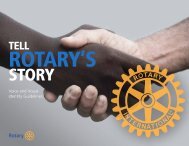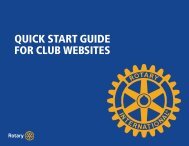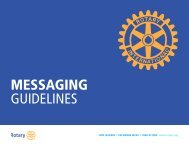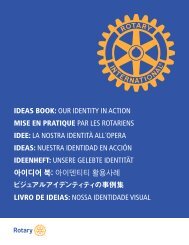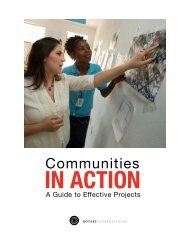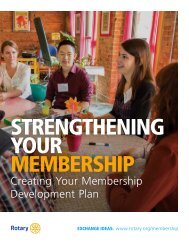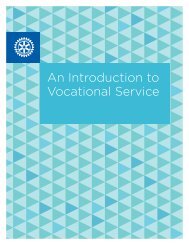Community Assessment Tools
Rotary International a companion piece to communities in action
Rotary International a companion piece to communities in action
You also want an ePaper? Increase the reach of your titles
YUMPU automatically turns print PDFs into web optimized ePapers that Google loves.
2. Asset Inventory<br />
An asset inventory is a technique for collecting information<br />
about a community through observation. It’s similar to a<br />
shopkeeper taking stock of merchandise, but instead of cataloguing<br />
products in a store, community members catalogue<br />
assets in their community. It works best when conducted at a<br />
community meeting or gathering.<br />
To conduct the inventory, small teams of participants walk<br />
around their community identifying people, places, and<br />
things they think are valuable. Team members then discuss<br />
their choices, create a list for the team, and share it with the<br />
larger group.<br />
Asset inventory session plan<br />
This session plan for conducting a sample inventory can be<br />
adapted to fit your club’s specific needs.<br />
Objectives<br />
• Identify community assets that members of the<br />
community think are important to community<br />
development.<br />
• Reveal why people believe these assets are<br />
important.<br />
Time<br />
1-1½ hours<br />
Preparation<br />
Choose an appropriate meeting location in the target community.<br />
You can make the inventory part of a regular community<br />
meeting or call a special meeting for it. If you plan<br />
to hold a special meeting, find a location and time that will<br />
be convenient for most people in the community. The ideal<br />
group size is 20 to 30 participants, but this activity can be<br />
adapted for smaller or larger groups.<br />
Visit the meeting location to see how large it is, and tour<br />
the community. Because you’ll be asking participants to<br />
walk around the community for about 30 minutes, decide<br />
the boundaries in advance. You may also want to prepare a<br />
handout or poster describing the asset inventory procedures.<br />
Materials<br />
For participants<br />
• Pens or pencils<br />
• Paper or notebooks<br />
• Handout with asset inventory directions (optional)<br />
For facilitators<br />
• Map of the community, if available<br />
• Chalkboard or dry-erase board, if available<br />
Procedures<br />
1. Introduce yourself and explain the purpose of your<br />
assessment. (5 minutes)<br />
2. Randomly divide participants into groups of four to<br />
six. (5 minutes)<br />
3. Ask each group to take a few minutes for introductions<br />
and to choose a team leader who will keep<br />
track of time, make sure the group stays on task,<br />
and report back to the larger group at the end of the<br />
meeting. (5 minutes)<br />
4. Give participants a brief overview of the activity.<br />
Explain that they will be walking around the community<br />
to identify items they think are important to<br />
the community. If necessary, provide examples<br />
of community assets. Be sure to explain that each<br />
group member should identify at least one item.<br />
(5 minutes)<br />
5. Distribute the activity materials to participants.<br />
(2 minutes)<br />
6. Have group leaders take their teams out into the<br />
community to identify assets. (20-30 minutes)<br />
7. After groups return, ask them to discuss their findings<br />
among themselves. Visit each group during the<br />
discussion period to monitor its progress and answer<br />
questions. (10 minutes)<br />
8. Ask each group to develop a list of 5 to 10 assets<br />
they think are most important to the development of<br />
the community. (15 minutes)<br />
9. Invite group leaders to briefly share their lists and<br />
explain choices. Record the lists on a chalkboard or<br />
dry-erase board. (10 minutes)<br />
10. Discuss the assets that groups had in common.<br />
Why were these items considered important? Did<br />
any groups identify different items? If yes, why were<br />
these items chosen? (30 minutes)<br />
11. Collect all the lists and keep them for reference when<br />
evaluating your asset inventory.<br />
Variations<br />
• Divide participants into groups by gender, age, or<br />
profession to reveal differences in the way different<br />
groups view the community. Or hold separate asset<br />
inventory sessions where you invite only men, only<br />
women, or only young people.<br />
• If you’re short on time, you might skip the walk<br />
around the community.<br />
<strong>Community</strong> <strong>Assessment</strong> <strong>Tools</strong> 3





